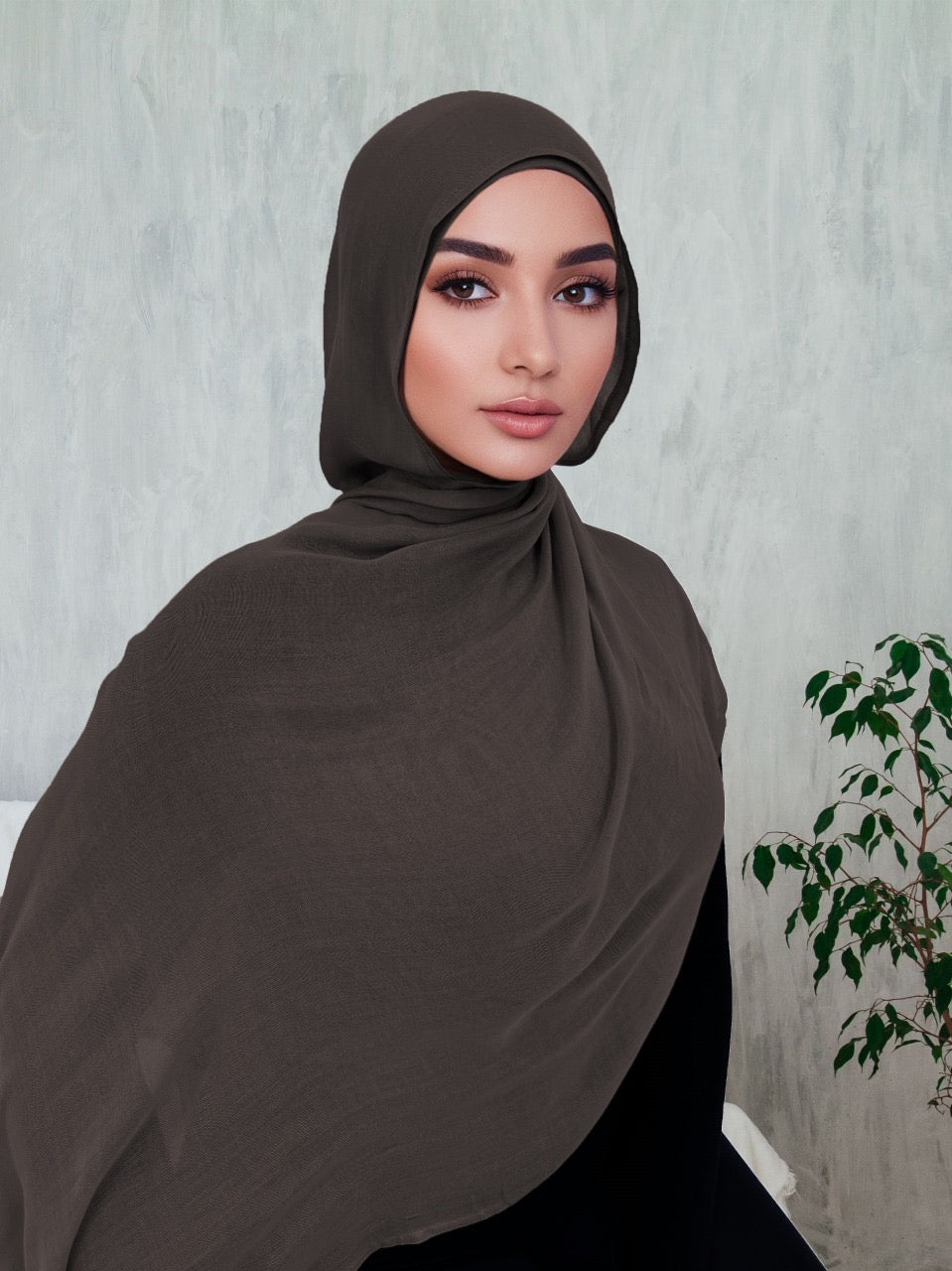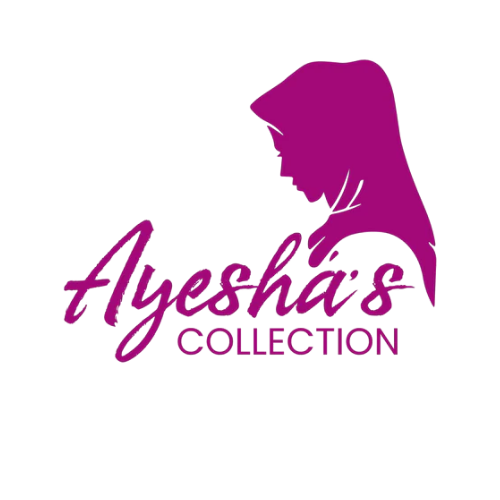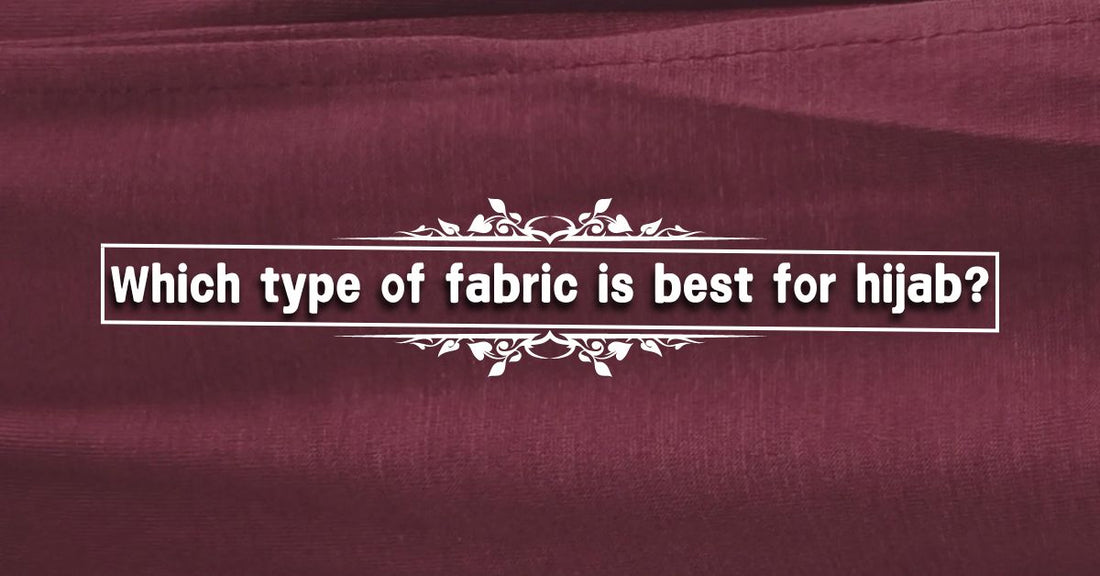Discover the top fabrics for hijabs and how they impact your comfort, style, and functionality. We'll explore various materials, their benefits, and how to choose the right fabric for different occasions. Whether you're new to wearing hijabs or looking to refresh your wardrobe, understanding the best fabrics can make all the difference.
I’ve spent years trying out different hijab fabrics, and it’s amazing how much the material can change the entire experience. There were times when I chose a fabric just because it looked pretty, only to regret it later when it didn’t hold up throughout the day. This journey taught me that the right fabric is essential not only for comfort but also for feeling confident.
Choosing the right fabric is crucial for anyone who wears hijabs regularly. The wrong choice can leave you feeling uncomfortable or constantly adjusting throughout the day. In this guide, you’ll learn about different hijab fabrics, their unique properties, and how to pick the best one for your needs.
The Best Fabrics for Hijabs: A Comprehensive Guide

Cotton
Benefits: Cotton is a classic choice for hijabs, known for its breathability and softness. It’s a fabric that allows your skin to breathe, making it comfortable for all-day wear. Cotton hijab is also highly absorbent, which helps keep you cool in warmer weather. Another advantage of cotton is its durability. It’s a fabric that can withstand frequent washing and daily use without losing its shape or texture. Additionally, cotton is easy to care for; it can be machine-washed and doesn’t require any special treatment.
Drawbacks: Despite its many benefits, cotton does have some downsides. It can be a bit heavy, especially in thicker weaves, which might not be ideal for those who prefer a lighter feel. Cotton also tends to wrinkle easily, which can affect the polished look you may be aiming for. Ironing or steaming your cotton hijabs might become a regular task to keep them looking crisp. Additionally, in humid weather, cotton can absorb moisture and feel damp, which may be uncomfortable.
Best for: Cotton hijabs are perfect for daily wear and casual settings. They offer the right balance of comfort and practicality, making them a staple in many wardrobes. Whether you're running errands, going to work, or just lounging at home, a cotton hijab is a reliable choice that will keep you comfortable throughout the day.
Modal
Benefits: Modal is a modern fabric that’s gaining popularity for its luxurious softness and lightweight feel. Made from beech tree pulp, modal is a type of rayon that’s known for its smooth texture and excellent draping qualities. Unlike cotton, modal has a slightly silky finish that feels gentle against the skin. It’s a breathable fabric that doesn’t cling, making it a great option for those who want comfort without compromising on style. Additionally, modal retains its color and shape well, even after multiple washes, which means your hijabs will look new for longer.
Drawbacks: While modal is comfortable and stylish, it can be less durable than other fabrics. Modal fibers are more delicate, so they may be prone to pilling or tearing with rough use. This fabric also requires special care to maintain its softness and appearance. For example, modal hijabs may need to be hand-washed or washed on a delicate cycle, and air-drying is recommended to prevent shrinkage. These extra steps can be inconvenient for those who prefer low-maintenance fabrics.
Best for: Modal hijabs are ideal for those looking for a blend of comfort and elegance. They are particularly well-suited for formal events, where you want to look polished without sacrificing comfort. The drapability of modal makes it easy to style in various ways, whether you prefer a more structured look or a loose, flowing style.
Chiffon
Benefits: Chiffon is a lightweight, sheer fabric that exudes elegance and sophistication. It’s made from silk, polyester, or nylon, and is known for its airy, flowy quality. Chiffon hijabs are often chosen for their delicate appearance and how they add a touch of grace to any outfit. The fabric is lightweight and breathable, making it comfortable to wear even in warmer weather. Chiffon also drapes beautifully, creating a soft and flattering silhouette that enhances any look.
Drawbacks: The main drawback of chiffon is its sheerness. Because it’s a lightweight and semi-transparent fabric, chiffon often requires layering or an undercap to ensure full coverage. This can add an extra step to your routine, which might be inconvenient if you’re looking for a quick and easy hijab option. Additionally, chiffon can be a bit slippery, which makes it more challenging to style and keep in place, especially if you’re new to wearing hijabs or prefer fabrics that stay put.
Best for: Chiffon hijabs are best reserved for special occasions and evening wear. Their elegant, flowy nature makes them perfect for formal events, weddings, or any situation where you want to look your best. With the right styling and a bit of patience, a chiffon hijab can elevate your outfit and make you feel effortlessly chic.
Georgette
Benefits: Georgette is a fabric similar to chiffon but with a slightly heavier and more textured feel. It’s semi-sheer and has a soft, slightly crinkled surface that gives it a unique appearance. Georgette is known for its ability to maintain its shape well, which makes it easier to style compared to chiffon. It’s also more opaque, offering better coverage while still being lightweight and comfortable to wear. Georgette is a versatile fabric that combines elegance with ease of use, making it a favorite for many.
Drawbacks: Despite its advantages, georgette can be slightly difficult to handle, especially if you’re not familiar with the fabric. Its textured surface, while adding visual interest, can make it harder to achieve a smooth, polished look. Additionally, because it’s semi-sheer, georgette may still require an undercap or careful layering, depending on your preference for coverage.
Best for: Georgette hijabs are an excellent choice for formal and semi-formal events. They strike a nice balance between structure and fluidity, offering a polished yet relaxed look. Whether you’re attending a wedding, a dinner party, or any event that calls for a touch of elegance, a georgette hijab will help you achieve a sophisticated appearance without much effort.
Jersey
Benefits: Jersey is a stretchy, comfortable fabric that’s easy to wear and incredibly versatile. Made from cotton, synthetic fibers, or a blend of both, jersey hijabs are known for their elasticity and ability to conform to your head shape. This makes them perfect for achieving a snug, secure fit without the need for pins or excessive styling. Jersey hijab is also breathable and soft, making it a great choice for everyday wear. It’s a low-maintenance fabric that’s easy to care for and doesn’t require ironing, which is a major plus for those with busy lifestyles.
Drawbacks: One of the main drawbacks of jersey fabric is that it may not hold its shape as well as other materials. Over time, jersey hijabs can stretch out, especially if they’re worn frequently. This can result in a less structured look, which might not be ideal for those who prefer a more polished appearance. Additionally, while jersey is comfortable, it’s generally thicker than other fabrics, which could make it feel warmer in hot weather.
Best for: Jersey hijabs are best suited for casual, everyday use. They’re perfect for running errands, going to the gym, or just lounging around the house. Their ease of wear and care makes them a go-to option for many, especially for those who prioritize comfort and convenience.
Silk
Benefits: Silk is the epitome of luxury when it comes to hijab fabrics. It’s smooth, soft, and has a natural sheen that adds an air of elegance to any outfit. Silk hijabs are incredibly lightweight and drape beautifully, creating a fluid, graceful look. Silk is also a natural fiber, which means it’s breathable and gentle on the skin, making it a great option for those with sensitive skin. The luxurious feel of silk can make you feel special, whether you’re dressing up for a formal event or simply want to add a touch of elegance to your day.
Drawbacks: The luxury of silk comes at a price, both literally and figuratively. Silk hijabs are expensive, and they require careful handling to maintain their quality. Silk is delicate and can easily get stained or damaged, so it’s often recommended to dry clean silk hijabs or wash them by hand with gentle detergent. Additionally, silk can be slippery, making it more challenging to style and keep in place, especially if you’re active or moving around a lot.
Best for: Silk hijabs are best reserved for formal events and special occasions. They’re the perfect choice when you want to make a statement and feel truly elegant. Whether it’s a wedding, a fancy dinner, or a celebration, a silk hijab will elevate your look and make you feel confident and chic.
How to Choose the Right Hijab Fabric

Consider Your Climate
Hot Weather: When the temperature rises, choosing a hijab fabric that’s lightweight and breathable is key. Fabrics like cotton and chiffon are excellent choices. Cotton allows air to circulate, keeping you cool and comfortable throughout the day. Chiffon, while slightly sheer, is also lightweight and flowy, making it a great option for staying cool while still looking stylish.
Cold Weather: In colder climates, you’ll want to opt for warmer fabrics that provide insulation. Jersey is a good option because it’s thicker and has a bit of stretch, which helps keep you warm while still being comfortable. Modal is another great choice for cold weather; it’s soft, slightly thicker than chiffon, and provides a bit more warmth. These fabrics can help you stay cozy while still allowing for a variety of styles.
Determine Your Purpose
Everyday Use: For daily wear, you need fabrics that are durable, easy to care for, and comfortable for long periods. Cotton and jersey are perfect for this. Cotton is resilient and can withstand frequent washing, making it a practical choice for everyday use. Jersey is low-maintenance and doesn’t require ironing, which makes it convenient for busy days when you don’t have time to fuss with your hijab.
Special Occasions: When it comes to special events or formal occasions, elegance is key. Fabrics like silk and georgette are ideal for these situations. Silk offers a luxurious, smooth finish that looks and feels sophisticated. Georgette, with its semi-sheer texture, adds a touch of elegance while still being relatively easy to style. These fabrics can elevate your outfit and make you feel confident and chic.
Think About Your Personal Comfort
Sensitivity: If you have sensitive skin, it’s important to choose fabrics that are gentle and hypoallergenic. Soft fabrics like cotton and modal are great choices because they are less likely to irritate your skin. These materials are smooth and breathable, which helps prevent discomfort and keeps your skin happy.
Allergies: For those with allergies or sensitivities to synthetic materials, natural fibers are the best option. Cotton, for example, is a natural fabric that is less likely to cause allergic reactions. Silk, although luxurious, is also a natural fiber that can be suitable for sensitive skin if you handle it with care. Opting for natural fibers can help you avoid irritation and ensure that your hijab is comfortable to wear all day long.
Caring for Your Hijab Fabrics
General Care Tips
Washing: Proper washing is essential to maintain the quality and longevity of your hijabs. Always follow fabric-specific instructions to avoid damage. For most hijabs, using a mild detergent and cold water is best. Avoid harsh chemicals like bleach, as they can weaken the fabric and cause discoloration. If your hijab is machine-washable, place it in a mesh laundry bag to prevent it from getting tangled or stretched. For hand-washing, gently swirl the fabric in water without rubbing or wringing it out, as this can cause the fibers to break down over time. Following these steps will help keep your hijabs looking fresh and new.
Storage: Storing your hijabs properly is just as important as washing them correctly. Store your hijabs in a cool, dry place to avoid damage from moisture, which can lead to mold and mildew. Hanging your hijabs on a hanger or using a hijab organizer can prevent wrinkles and creases. If you prefer to fold your hijabs, make sure they are stored flat and not under heavy items that could cause them to lose their shape. Keeping your hijabs in a well-ventilated area will also help preserve their color and texture, ensuring they stay in top condition for longer.
Special Care for Delicate Fabrics
Silk: Silk hijabs require special attention due to their delicate nature. Hand washing is the best option for silk, as it helps preserve the fabric’s sheen and softness. Use lukewarm water and a mild detergent specifically designed for silk. Gently swirl the hijab in the water, avoiding any harsh rubbing or scrubbing. After washing, rinse thoroughly with cool water to remove any detergent residue. Instead of wringing out the water, gently press the fabric between towels to absorb excess moisture. If you prefer, silk can also be dry-cleaned, which is a safe option to ensure your hijab stays in pristine condition.
Chiffon and Georgette: Chiffon and georgette are both lightweight, flowy fabrics that need gentle care to maintain their appearance. When washing these fabrics, it’s best to use cold water and a gentle detergent. Hand washing is recommended to avoid the delicate fibers from getting damaged in the washing machine. If you do use a machine, place the hijabs in a mesh laundry bag and select a delicate cycle. After washing, allow the hijabs to air dry by laying them flat on a clean towel or hanging them up. Avoid using a dryer, as the heat can cause the fabric to shrink or lose its shape. Taking these extra steps will help your chiffon and georgette hijabs maintain their elegance and flow.
Conclusion
Choosing the right hijab fabric is key to balancing comfort, style, and functionality. Whether you prefer the breathability of cotton for daily wear, the elegance of silk for special occasions, or the versatility of chiffon for various settings, there’s a fabric to suit every need. Based on my experience, cotton is my top pick for everyday comfort, but it's important to consider what works best for you.
FAQ
What is the most breathable hijab fabric?
The most breathable hijab fabric is cotton. Cotton is a natural fiber that allows air to circulate freely, making it ideal for keeping cool in warm weather. It’s also soft and gentle on the skin, which adds to its comfort. Cotton’s ability to wick away moisture helps keep you dry, even on hot days. This makes it a popular choice for those who prioritize comfort and breathability in their hijabs.
Which fabric is best for hot weather?
For hot weather, chiffon and cotton are the best fabrics to choose. Chiffon is lightweight and airy, which makes it great for staying cool. It has a slightly sheer quality that allows for better air circulation, keeping you comfortable in the heat. Cotton is also excellent for hot weather due to its breathability and moisture-wicking properties. Both fabrics are comfortable and stylish, making them perfect for summer or hot climates.
How do I care for silk hijabs?
Caring for silk hijabs requires a gentle touch. Hand wash your silk hijab in lukewarm water using a mild detergent designed for delicate fabrics. Avoid wringing or twisting the fabric to prevent damage. After washing, rinse thoroughly with cool water and gently press out the excess water using a clean towel. You can also opt to dry clean your silk hijabs for a more professional care routine. Always store silk hijabs in a cool, dry place, away from direct sunlight to preserve their color and texture.
Can I wear chiffon hijabs daily?
Yes, you can wear chiffon hijabs daily, but it depends on your comfort and the occasion. Chiffon is lightweight and offers a flowy look, making it a stylish choice for everyday wear. However, since chiffon can be slightly sheer, you might need to layer it with an undercap or pair it with a less sheer fabric for better coverage. While chiffon is elegant and suitable for daily use, it requires careful handling to avoid snags and tears, so keep that in mind if you’re considering it for everyday wear.


